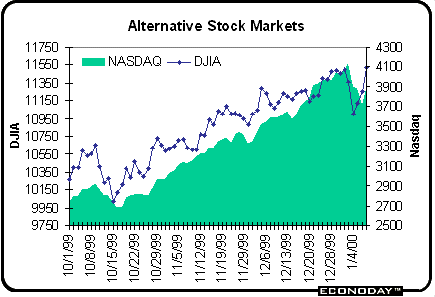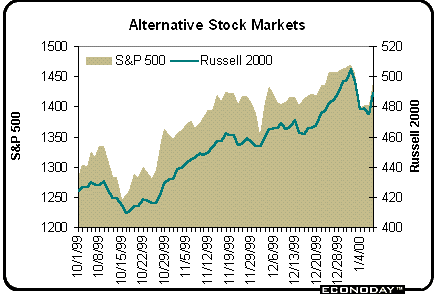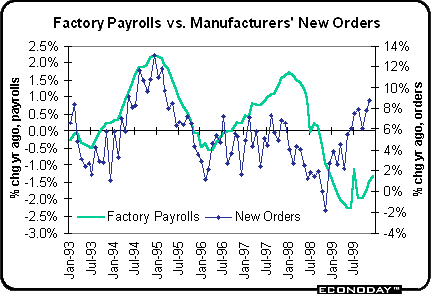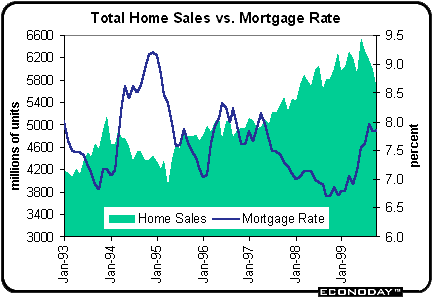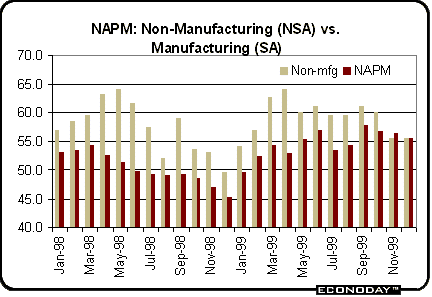| |||||||||||||||||||||||||||||||||||
| Previous Articles |
A Tale of
Two Markets
The S&P 500 and the Russell 2000 behaved more like the NASDAQ market this week. They did recuperate some of the losses by Friday afternoon, but fell a good bit further than the Dow Industrials. This shouldn't be too surprising. After all, several tech stocks with high market capitalization have been added to the S&P 500 in the past year. Furthermore, the bulk of the growth in the Russell 2000 in the last two weeks of December was attributable basically to the small cap tech sector. If techs benefited in December, these same stocks were hit in January.
Treasury
prices showed jagged moves in first week of 2000
Markets
at a Glance
(BP = basis points; stock price indices are rounded) Clinton
re-appoints Greenspan to 4-year term as Fed chairman The more interesting fall-out from the re-appointment announcement was the various op-ed pieces in the major financial newspapers. In all cases, the views expressed were of one mind: the Fed should not personalize policy actions in the form of Alan Greenspan. Rather, policy decisions should be formalized to introduce inflation targeting. If the Fed were to choose an inflation-target, all subsequent Fed chairmen and governors would be forced to follow this rule. All agreed that the United States was lucky to have Greenspan's inflation-fighting resolve and his ability to skirt the minefields of this new economy. Yet, the general consensus was that the U.S. might not be so lucky in the future in terms of maintaining price stability - or finding such a talented policy-maker. As a result, all propose an adoption of an inflation-target for policy-making now that Greenspan is still in place. Employment
growth ends year on a strong note
The bulk of the growth was in the service sector, as usual. However, it appears that factory payrolls stopped bleeding so profusely. Manufacturing employment was virtually unchanged for the second straight month. The chart below compares yearly changes in factory employment to the yearly growth in manufacturers' new orders. The series tend to move together. In 1999, however, factory orders grew more rapidly than employment. It is only in the past couple of months that factory employment has started to turn around. Incidentally, the most recent report shows that factory orders increased 1.2 percent in November, but previous months' gains were more modest.
The civilian unemployment rate remained unchanged at 4.1 percent in December. The labor force and household employment both registered healthy gains for the month. The rise in the labor force should be at least somewhat reassuring to Fed officials who are worried about tight labor markets and the shrinking pool of available workers. The main reason that tight labor markets strike fear in the hearts of Fed officials and financial market players is that they could incur accelerating wages. In fact, average hourly earnings did rise 0.4 percent in December, but the last month of a quarter often brings a wage burst, which is usually offset in the subsequent month. The chart below shows that the yearly rise in average hourly earnings has stabilized in a tight range between 3.5 and 4 percent in the past year even as the unemployment rate has settled at 30-year lows
The bottom-line on the employment situation?The year ended on a strong note. Employment gains were robust. This helps to boost consumers' disposable income - and that generates extra spending. Fed officials will no doubt be concerned that activity did not moderate in December. At the same time, the Fed can't become overly anxious about inflation pressures. Wages aren't accelerating. Immediately following the employment report, most economists agreed that the Fed could easily raise the federal funds rate target by 25 basis points at the February 1 - 2 FOMC meeting, but a 50 basis point hike was not in the cards. New home
sales plunge
The bottom-line on home sales? A moderation in home sales is consistent with the upward tilt in mortgage rates. In a rising interest rate environment, interest-sensitive purchases such as large ticket items and homes are the first to feel the pinch of rising costs. The Fed will be reassured that the three interest rate hikes they put in place last year began to have some impact on consumer purchases. Even with the recent drop in home sales, levels remain high by historical standards. This is not the beginning of a housing drought by any stretch of the imagination. Eventually, though, consumers will decrease their demand for home furnishings and appliances as housing investment slows. NAPM: Manufacturing index on the mend; non-manufacturing moderating? The NAPM survey edged down modestly in December, but the overall index still showed a healthy pace of manufacturing activity. The chart below compares the regular NAPM survey with the newer non-manufacturing NAPM. The newer index, which attempts to measure the service sector, is not seasonally adjusted and must be interpreted with caution. Note the dramatic seasonal variation in the unadjusted index. An interesting pattern has emerged however. The gap between the manufacturing and non-manufacturing index was wide in 1998 and early 1999, but narrowed significantly in the past several months. This could be reflecting some shift in the patterns of growth in different economic sectors.
The bottom-line on economic activity? Economists are generally forecasting that consumer spending will moderate in 2000 while export demand will accelerate and help boost manufacturing activity. The pattern of the two NAPM surveys supports this view recently. THE BOTTOM
LINE Looking Ahead:
Week of January 10 to January 14 Thursday Market players are looking for a 0.3 percent rise in the producer price index for December after last month's 0.2 percent gain. Excluding the volatile food and energy component, the PPI is expected to rise a more moderate 0.1 percent. If this forecast were realized, it would still be faster than November's core PPI which was unchanged for the month. Retail sales are expected to jump 1.0 percent in December, a bit better than November's 0.9 percent hike. Excluding the auto group, retail sales should increase 0.7 percent, nearly twice as fast as the previous month. Anecdotal evidence pointed to a robust holiday season for retailers. Friday Financial market participants are looking for an increase of 0.3 percent in December's consumer price index. This would be an acceleration over the gains of the past two months. Excluding the volatile food and energy components, the CPI should rise 0.2 percent, the same as the previous couple of months. Business inventories are predicted to post a gain of 0.4 percent for November, twice as fast as the increase reported in October. Manufacturers' inventories already reported a 0.5 percent gain for the month. Economists are predicting industrial production will rise 0.4 percent in December, a bit faster than the 0.3 percent gain recorded in November. This would boost the capacity utilization rate up a tad to 81.1 percent in December from the 81 percent rate of the previous two months. |
||||||||||||||||||||||||||||||||||||||||||



